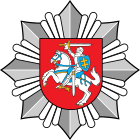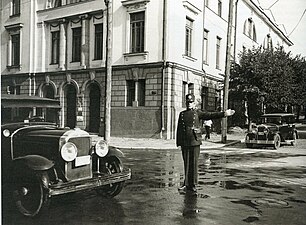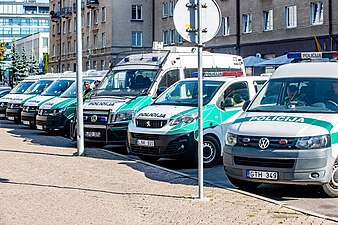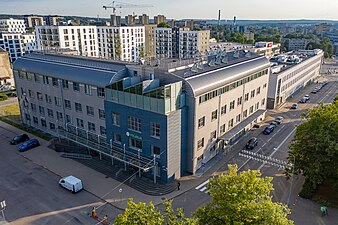Lithuanian Police Force (original) (raw)
From Wikipedia, the free encyclopedia
Law enforcement agency
| Lithuanian Police_Lietuvos Policija_ | |
|---|---|
 Insignia of the Lithuanian Police Insignia of the Lithuanian Police |
|
 Flag of the Lithuanian Police Flag of the Lithuanian Police |
|
| Agency overview | |
| Formed | 1990 |
| Employees | 7,007 (2021)[1] |
| Annual budget | €355 million (2025)[2] |
| Jurisdictional structure | |
| National agency | Lithuania |
| Operations jurisdiction | Lithuania |
| Governing body | Ministry of the Interior |
| Constituting instrument | Law on Police[3] |
| General nature | Civilian police |
| Operational structure | |
| Overseen by | Ministry of Internal Affairs |
| Headquarters | Saltoniškių g. 19, LT-08105 Vilnius, Lithuania |
| Agency executive | Arūnas Paulauskas, Police Commissioner General |
| Website | |
| policija.lrv.lt |
Law enforcement in Lithuania is the responsibility of a national police under the jurisdiction of the Interior Ministry. The main institution is the Lithuanian Police Department (Lithuanian: Lietuvos Policijos Departamentas) led by the Police Commissar General.
The origins of the Lithuanian police could be traced back to the Grand Duchy of Lithuania, when the first Boni Ordinis Commission (literally, Good Order Commission) was established in Gardinas in 1776 (later in Brest, Minsk, Kaunas and other cities).[4][5] These institutions were directly subordinate to the Sejm of the Polish–Lithuanian Commonwealth.[4] However, the regional magnates were resisting the reforms as they saw the new institutions as a restriction of their authority.[4]In 1775, the Permanent Council of the Polish–Lithuanian Commonwealth established a Police department, but it did not have the authority over the Boni Ordinis Commissions and served primarily as an advisory body.[4] In 1791, the Great Sejm established the Police Commission of the Polish-Lithuanian Commonwealth.[6] A separate Police Commission of the Grand Duchy of Lithuania with the headquarters in Vilnius was established in 1793.[6] It is considered to be the predecessor of the contemporary Ministry of the Interior.[4]
The origins of the contemporary police are the volunteer militia formed in 1918 after the declaration of the Republic of Lithuania.[3] The uniforms were approved in 1919 and the first laws regulating the police were adopted on 14 May 1920. The organisation was formally renamed to police on 1 January 2024.[3] The police was divided into public police and criminal police.[7] There were several reforms and reorganizations in the following years and the Police Department was established on 1 January 1935, which composed of public, border, railway, private and water police divisions.[3] In 1927, police employed 1262 officers, while in 1940 police had 2735 officers.[7]
The current form of police was established on 11 December 1990, following the adoption of the Law on Police.[3] In 1991, Lithuania joined Interpol.[8] Since joining the European Union, Lithuania is also a member of Europol.[8]

Lithuanian traffic police officer during the Interwar period.
Lithuanian police officers in 2022
Lithuanian police officer in 2022

Police cars in Vilnius
Structure and branches
[edit]
Lithuanian Police Department is established under the Ministry of the Interior.[9] It is led by the Police Commissioner General. The department consists of ten County Police Headquarters (Lithuanian: apskrities vyriausiasis policijos komisariatas, literally county chief police commissariat).[9] They are further divided into sub-units of local police.[10]
Additionally, the Police Department consists of the following specialized institutions:[9][10]

Headquarters of the Police Department (LTPD)
Vilnius County Police Headquarters
Vilnius County 1-st commissariat hq
Kaunas County Police Headquarters
Traffic Police Headquarters
Lithuanian police use the following system of ranks:[11][12]
| First rank officers |
|---|
 |
| Viršila |
| Sergeant |
- ^ "Policijos pareigūnų mažėja, bet traukiasi ir nusikalstamumas", osp.stat.gov.lt
- ^ "2025 – 2027 METŲ BIUDŽETO PROJEKTO APŽVALGA" (PDF). finmin.lrv.lt.
- ^ a b c d e "Lietuvos policija - Istorija" (in Lithuanian). Government of Lithuania. Archived from the original on 8 May 2021. Retrieved 28 April 2022.
- ^ a b c d e "LDK istorija: Policijos atsiradimas" [History of GDL: the emergence of the police] (in Lithuanian). 15min.lt. Archived from the original on 27 June 2023. Retrieved 27 June 2023.
- ^ Srogosz, Tadeusz (2000). Status of the Grand Duchy of Lithuania in police activities of the authorities at the time of decline of the 1st Commonwealth. Yearbook of Lithuanian History. ISBN 8323210675. Retrieved 27 June 2023.
- ^ a b Glemža, Liudas. "Policinių institucijų raida Lietuvos Didžiojoje Kunigaikštystėje 1775-1794 m" [Evolution of police institutions in the Grand Duchy of Lithuania in 1775-1794] (in Lithuanian). Yearbook of Lithuanian History. Retrieved 27 June 2023.
- ^ a b "Policija tarpukariu ir šiandien: mitai apie galingą stotą, faktai apie nusikalstamumą" (in Lithuanian). LRT. Archived from the original on 31 July 2021. Retrieved 27 June 2023.
- ^ a b "Lithuanian Criminal Police Bureau - Interpol". Government of Lithuania. Archived from the original on 16 September 2019.
- ^ a b c "Lietuvos policija" (in Lithuanian). LRT. Retrieved 27 June 2023.
- ^ a b "OSCE Polis - Lithuania". OSCE. Archived from the original on 6 May 2023. Retrieved 27 June 2023.
- ^ Lietuvos Respublikos vidaus tarnybos statuto patvirtinimo įstatymas. Retrieved 2020-03-04.
- ^ Gintaras Paulaskas "Vidaus tarnybos pareigūnų laipsniai." Retrieved 2020-03-04.







